- Join our Team
- Resources
-
Account
- |
- Cart
- EN FR

Intermold Korea
Moldcare, Korean distributor of our technical conversion solutions, exhibitor at Intermold Korea. Visit Moldcare web site!Thanks to Molcare for the pictures Intermold Korea [...]
March 13, 25

Global Industrie 2025 - Lyon France
Datakit is preparing to attend Global Industrie, Lyon, 11-14 March, to showcase its expertise in CAD data exchange solutions for professionals and Software Development Toolkit [...]
February 01, 25
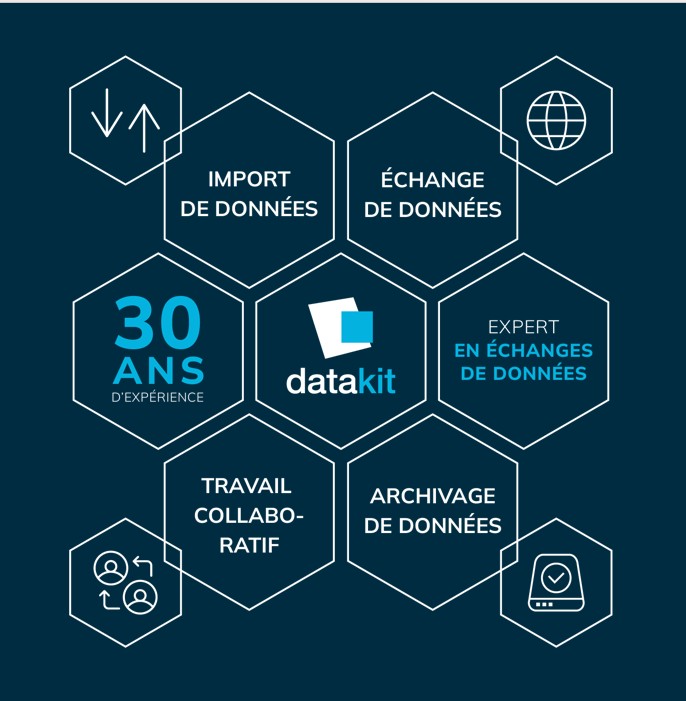
DATAKIT Webinar 30 minutes to find out more about converting CAD data
Soon available english recording
January 21, 25
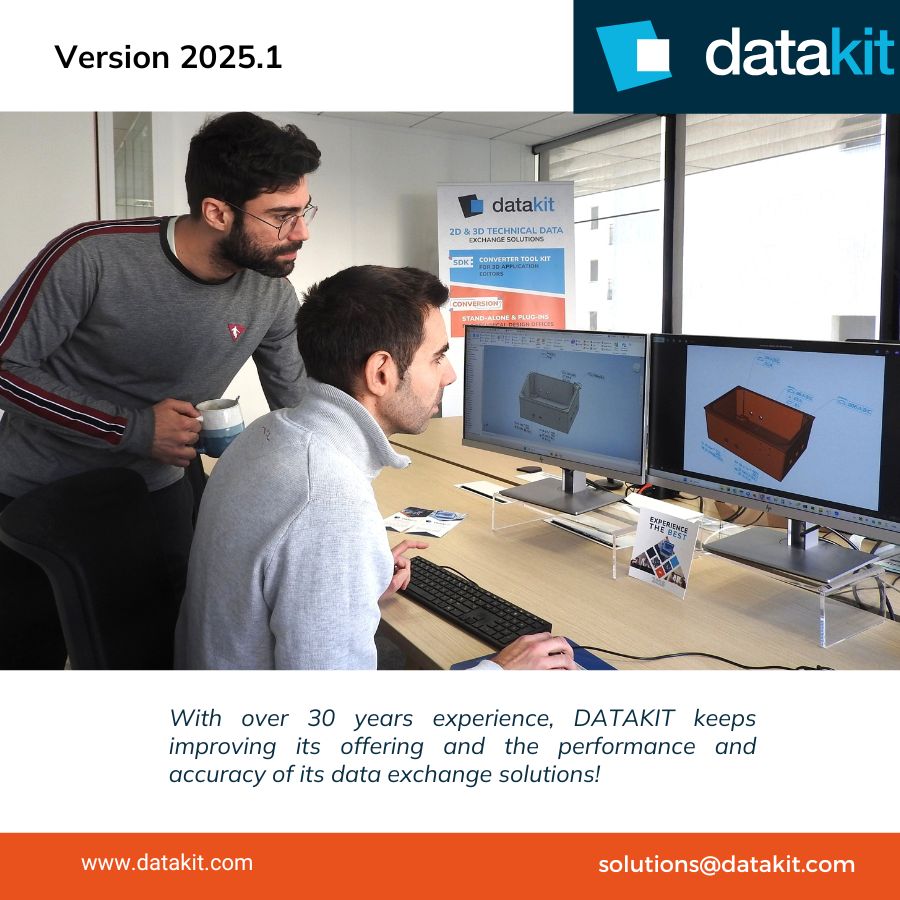
New version 2025.1!
When precision and reliability of 2D / 3D data exchange counts! With over 30 years experience, DATAKIT keeps improving its offering and the performance and accuracy of its data [...]
January 15, 25

Happy new year!
Experience the best, experience the best conversions in 2025 with Datakit solutions!
December 17, 24

JIMTOF 2024: The 32nd Japan International Machine Tool Fair
DataDesign showcased its digital transformation range of solutions during JIMTOF 2024, the 32nd Japan International Machine Tool Fair: from design, to manufacturing, machining, [...]
December 03, 24

Smart Construction EXPO - Korea - BIM
Moldcare Inc, a Korean reseller of our converters exhibited at Smart Construction EXPO last week a wide range of our convertors especially for the construction and building (BIM). [...]
November 28, 24
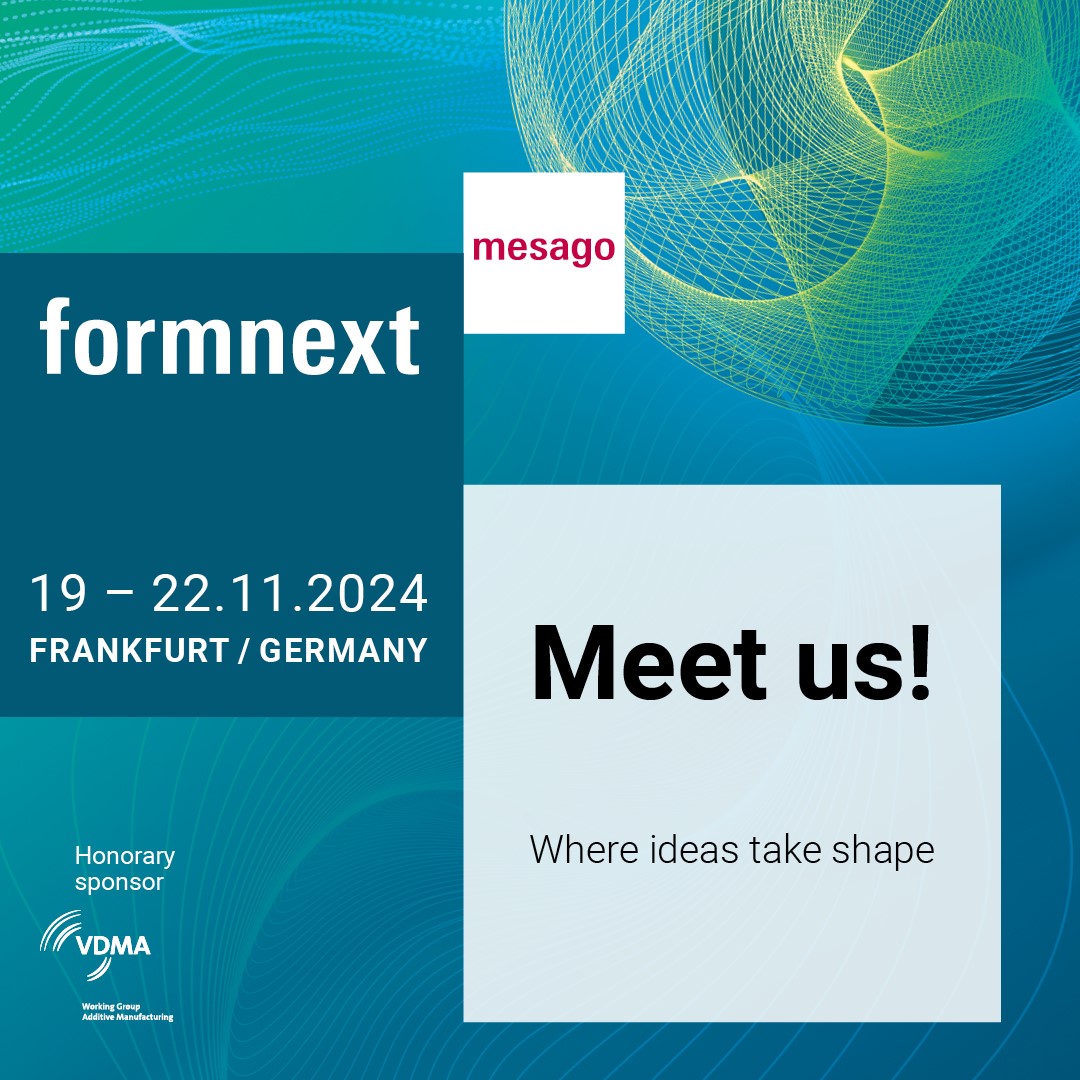
Formnext Frankfurt, November 2024
Datakit will be at the 2024 edition of the Formnext trade fair in Frankfurt to talk to experts from the world of 3D printing.To arrange an appointment during the show or learn [...]
November 19, 24

Webinar Cad data exchange convertors
Datakit proposes a webinar in french dedicated to its CAD Data exchange convertors for end-users, stand-alone convertors or plugins for RHINO or SOLIDWORKS. Please read the [...]
November 18, 24

Datakit's birthday
30 years' experience of data exchange !A look back at Datakit's anniversary in pictures !Look at the following MP4
October 17, 24
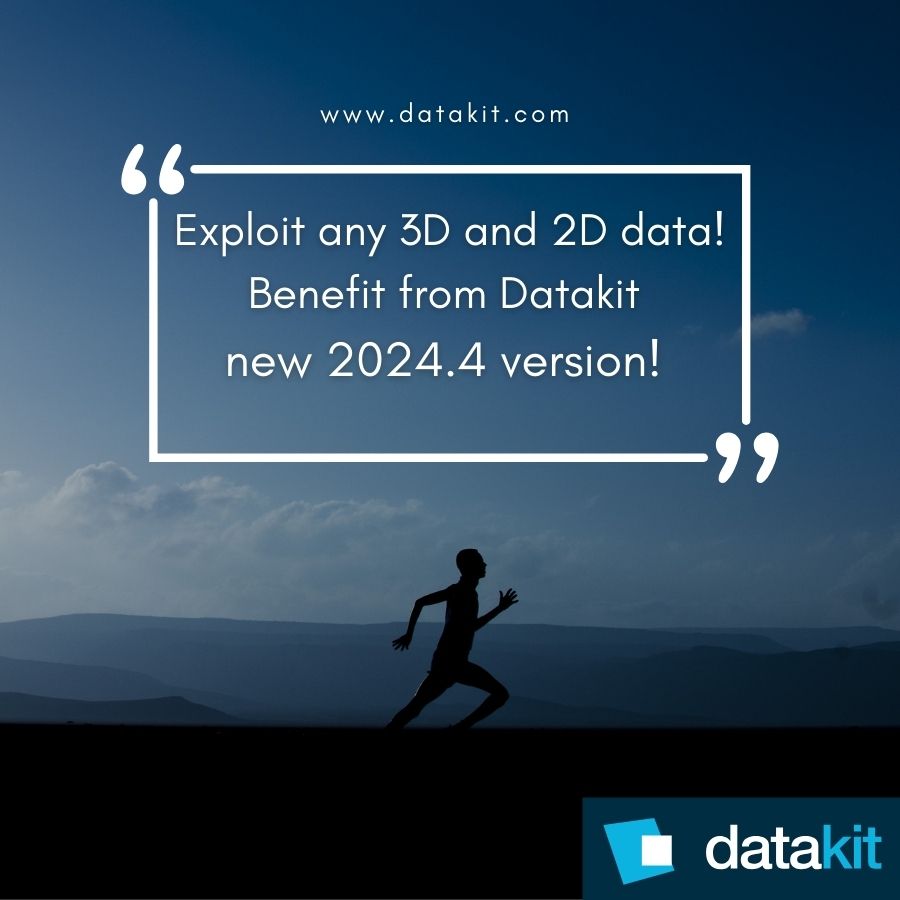
CrossManager V2024.4 extends today's CAD Software compatibility!
This new version highlights Datakit's expertise of over 30 years' experience in the conversion of 2D, 3D B-Rep, PMI / FD&T, metadata and mesh representations. With [...]
October 08, 24

DMS Kansai - Osaka - 2-4 October
DataDesign Co., Ltd, a japanese reseller of our converters will be exhibiting at DMS Kansai (Osaka) a wide range of solutions for manufacturing and industrial applications, [...]
October 02, 24
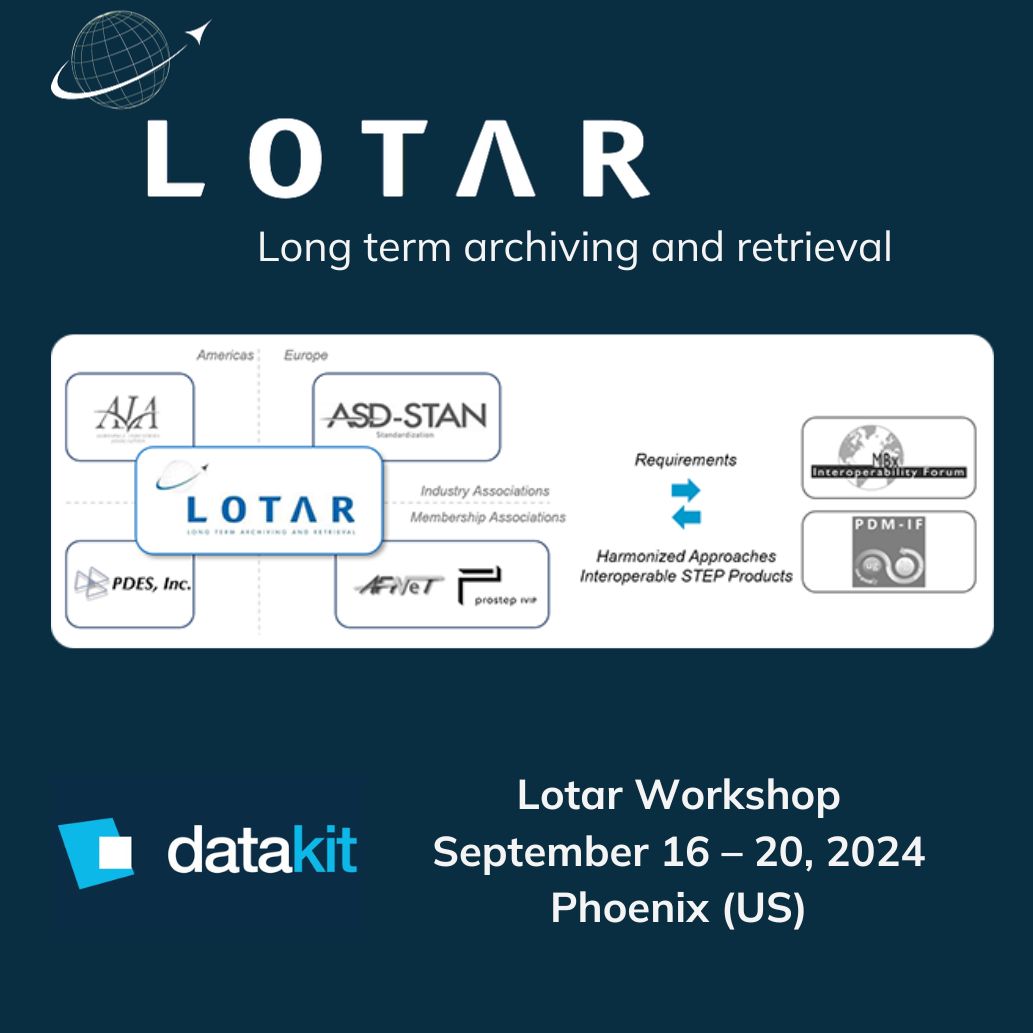
Datakit at the next round of the Managed Model-based 3D Engineering workshop
Datakit will take part in September 2024 at the next session of LOTAR hold in Phoenix (USA), combined with MBx-IF Workshop. Since its creation the prime objective of the LOTAR [...]
September 16, 24
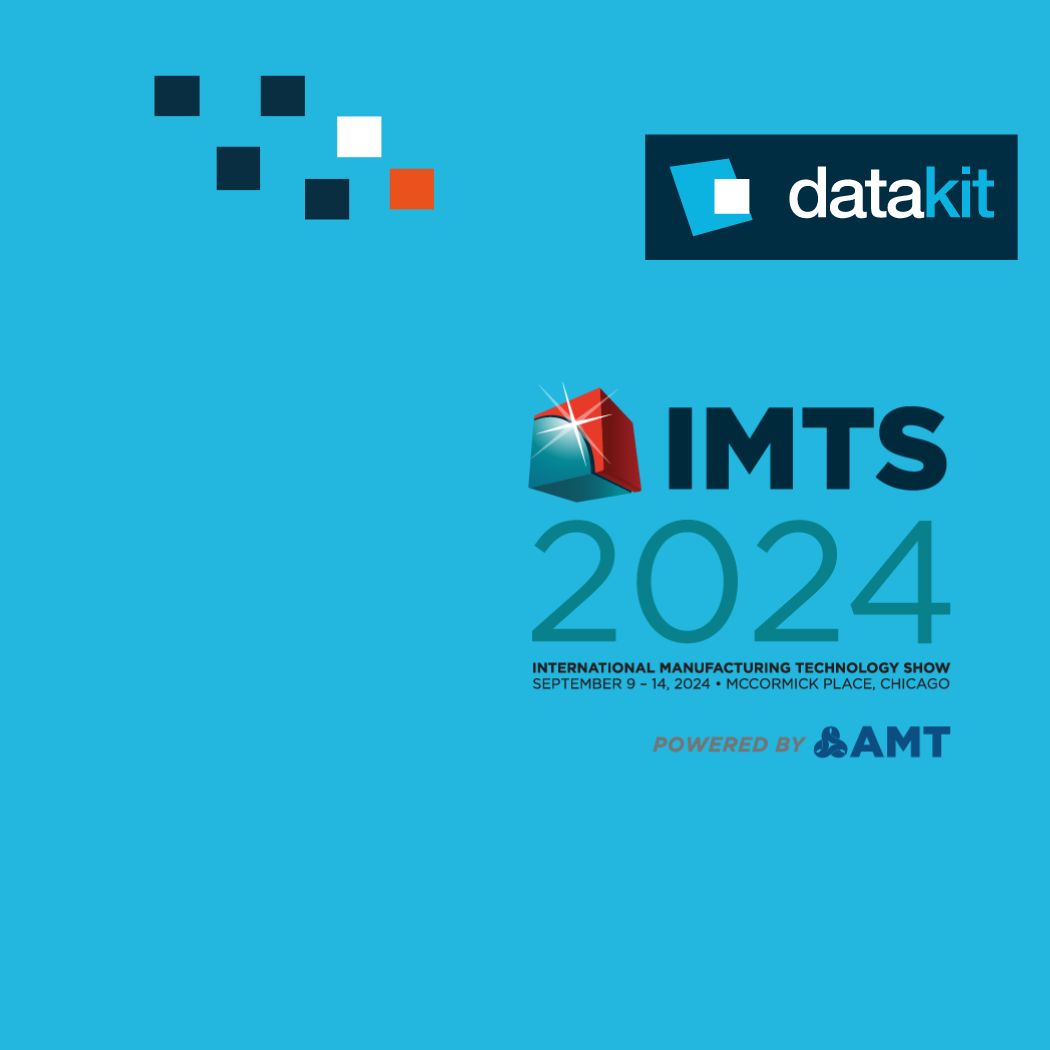
International Manufacturing Technology Show – IMTS
International Manufacturing Technology Show at McCormick Place, Chicago ILFrom around the globe, the industry gathers to discover the latest in innovations and technologies [...]
September 10, 24

Ready for version 2024.3 of Datakit technical data exchange solutions?
You will appreciate upcoming functionnalities, full compatibility with new versions of third-party vendors CAD software, and our solution to write PLM XML files*. Note that the [...]
July 15, 24
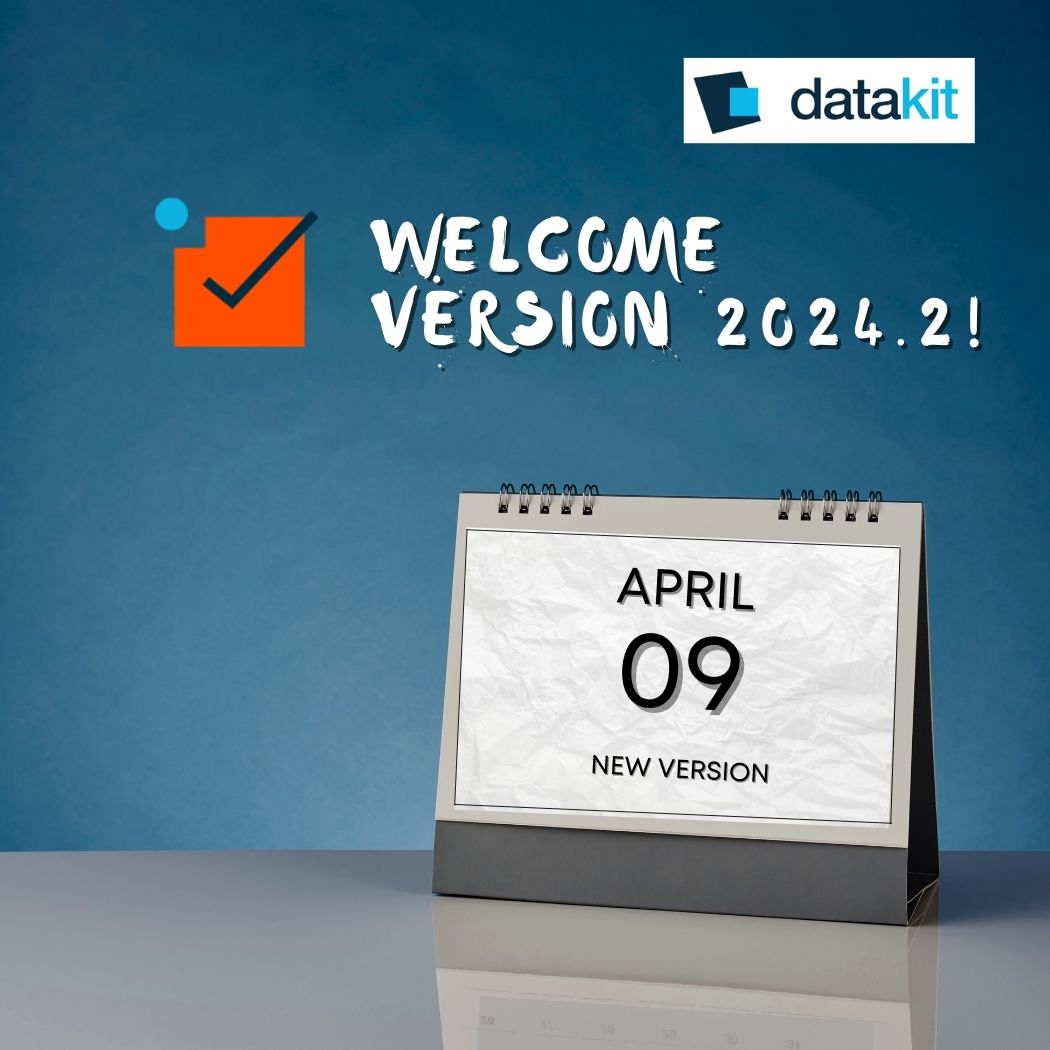
Datakit is excited to announce V2024.2 of its technical data exchange solutions
Like for any of the quarterly release of our Datakit solutions, we keep adding new features to help your decrease of time to design and made some major improvements to increase [...]
April 09, 24
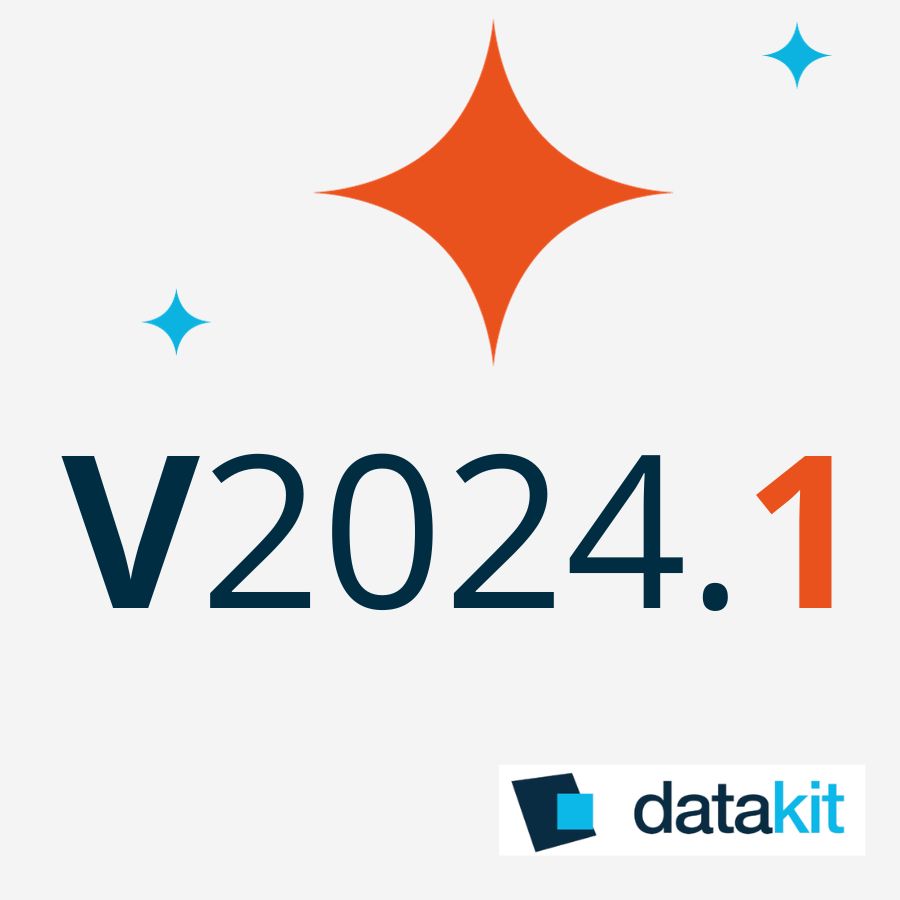
Datakit is delighted to announce its 2024.1 release
Make it happen! Datakit wishes you all the best for the New Year and is delighted to announce its 2024.1 release. With almost 100 releases of its solutions since the founding of [...]
January 04, 24

Philippe Blache has been appointed by the shareholders of Datakit as CEO
Philippe is an experienced manager within the software engineering field. He joined Datakit several months ago and takes the position of CEO as of November 9th following the [...]
November 23, 23

Datakit Version 24.1, the reference for exchanging CAD files with Rhino V8
Datakit is glad to inform you that users with converters under maintenance contracts are going to benefit from compatibility of their solutions with Rhino 8. The new V2024.1 [...]
November 21, 23
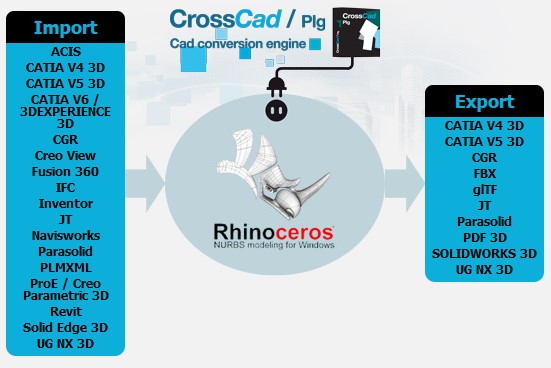
Datakit updated its converters
The release 2023.4 supports new versions of Parasolid, (36.0), Unigraphics (NX2306 series) and V2.0 release of Fusion 360 (2.0.01774 up to 2.0.16985) and offers a new converter for [...]
October 19, 23

Inauguration of our new offices
A big thank you to all the participants. It was a fun inauguration of our new offices for everyone!
October 16, 23
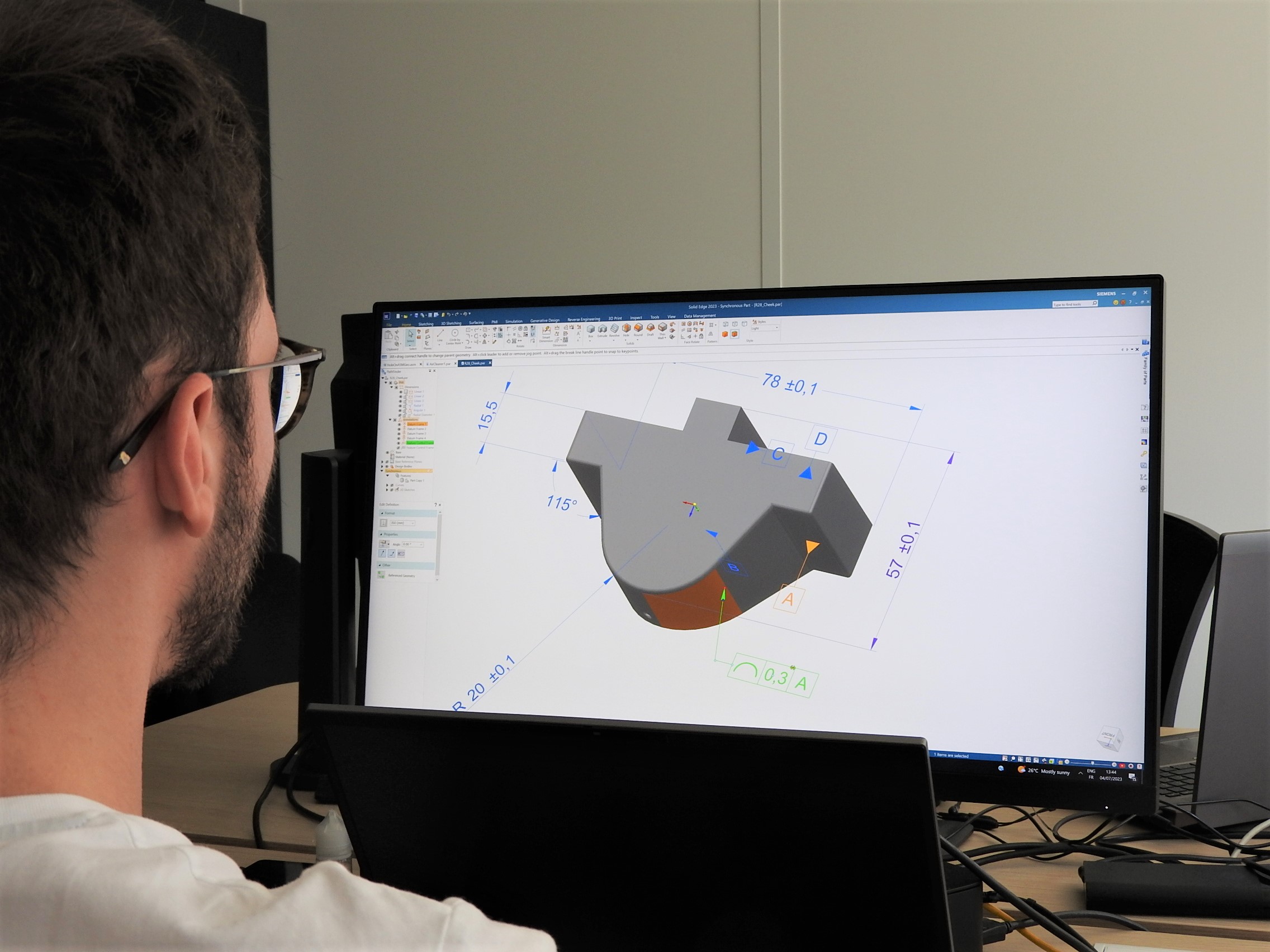
Version 2023.3 : Updates and availability of a SolidEdge PMI reading module
New version of Datakit convertersVersion V2023.3 is available since the beginning of July. It ensures compatibility with the new versions of ACIS 2023.1 modeler, Fusion 2.0.16265, [...]
July 17, 23
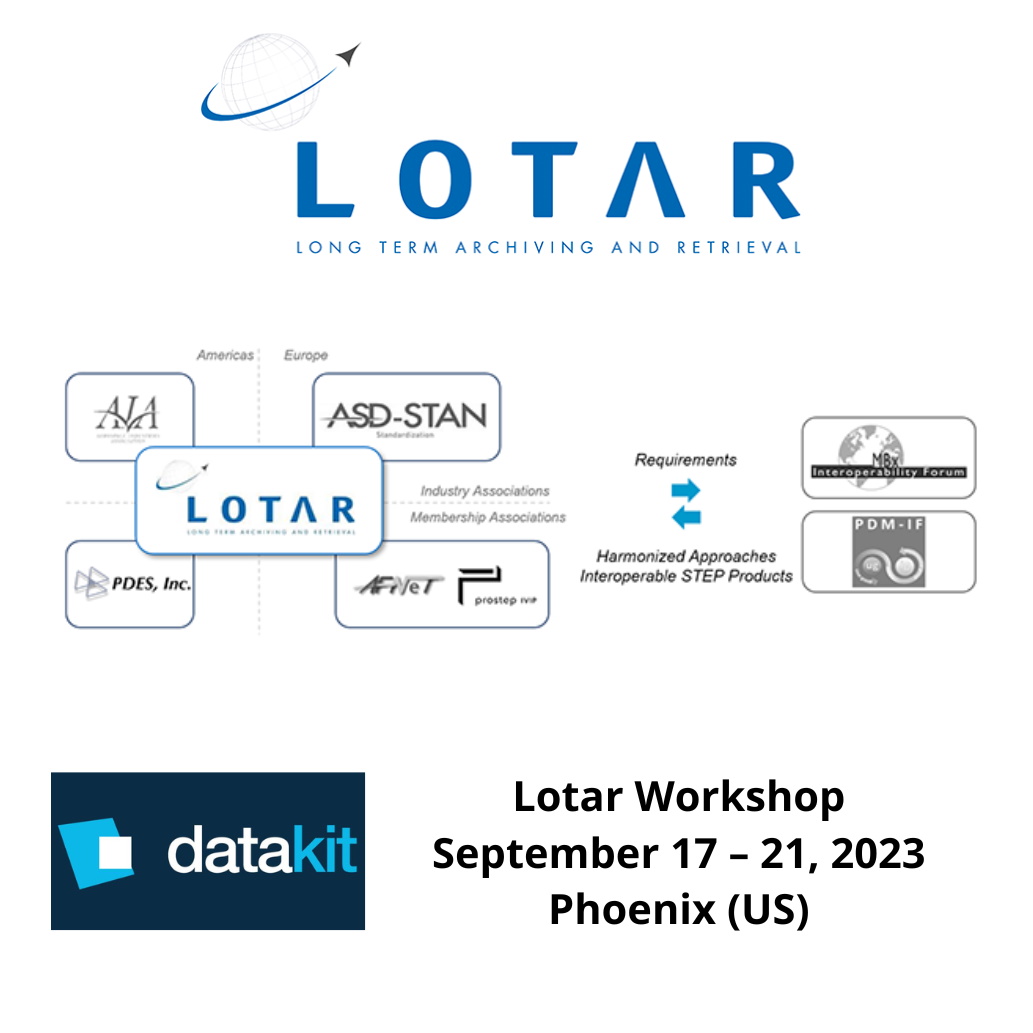
Lotar Workshop September 17 – 21, 2023 - Phoenix (US)
Datakit is a member of the LOTAR International and will take part at the workshop as a Cad Data Exchange solution provider. LOTAR International is a project being conducted by [...]
June 05, 23

AFNeT Standards Day
Datakit attentive to the needs of manufacturers regarding data exchanges standardization, at AFNeT Standards Day. This event brought together many engineering vendors for an [...]
June 01, 23
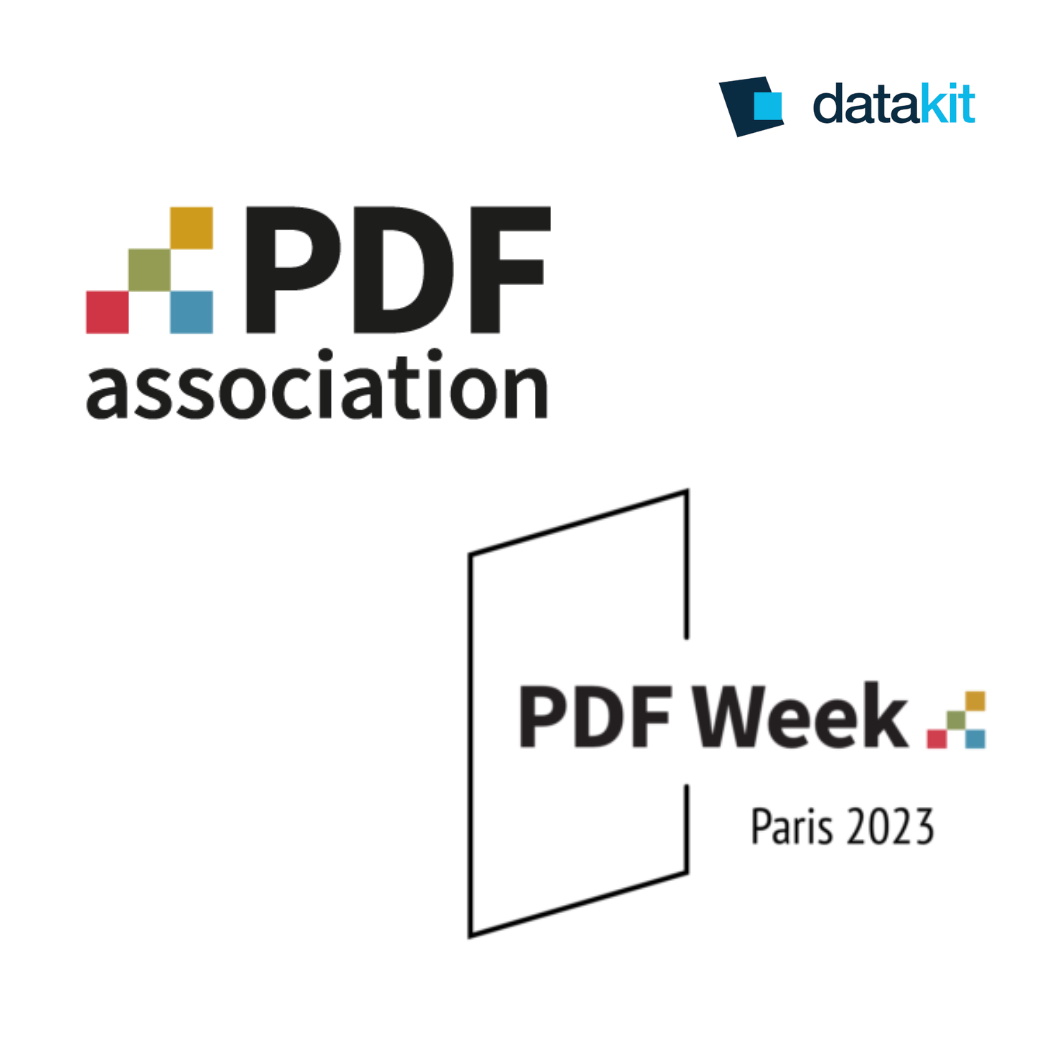
PDF Week Paris 2023
Datakit took the opportunity to meet and network with colleagues in the PDF space during PDF Week Paris 2023. The company Datakit is a member for a long time of the PDF [...]
June 01, 23
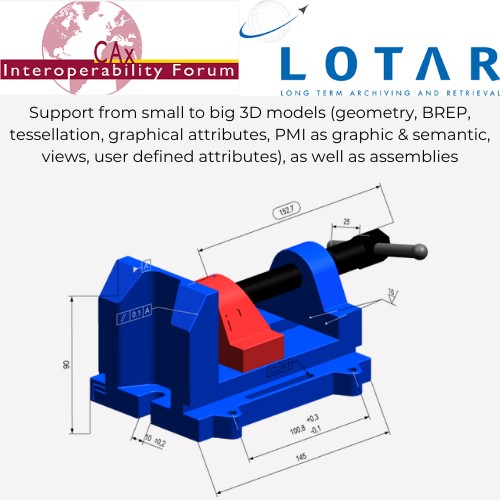
51th Cax Interoperability Forum
A few days ago, Datakit experts have taken part in the LOTAR/MBX-IF session in Toulouse including Cax Interoperability Forum in order to submit the recent evolutions of their read [...]
April 11, 23

Datakit announces the general availability of release V2023.2
This release guarantees complete compatibility with the most recent updates of 3D engineering software or modelers. Users of Datakit converters are now able to read files of ACIS [...]
April 04, 23
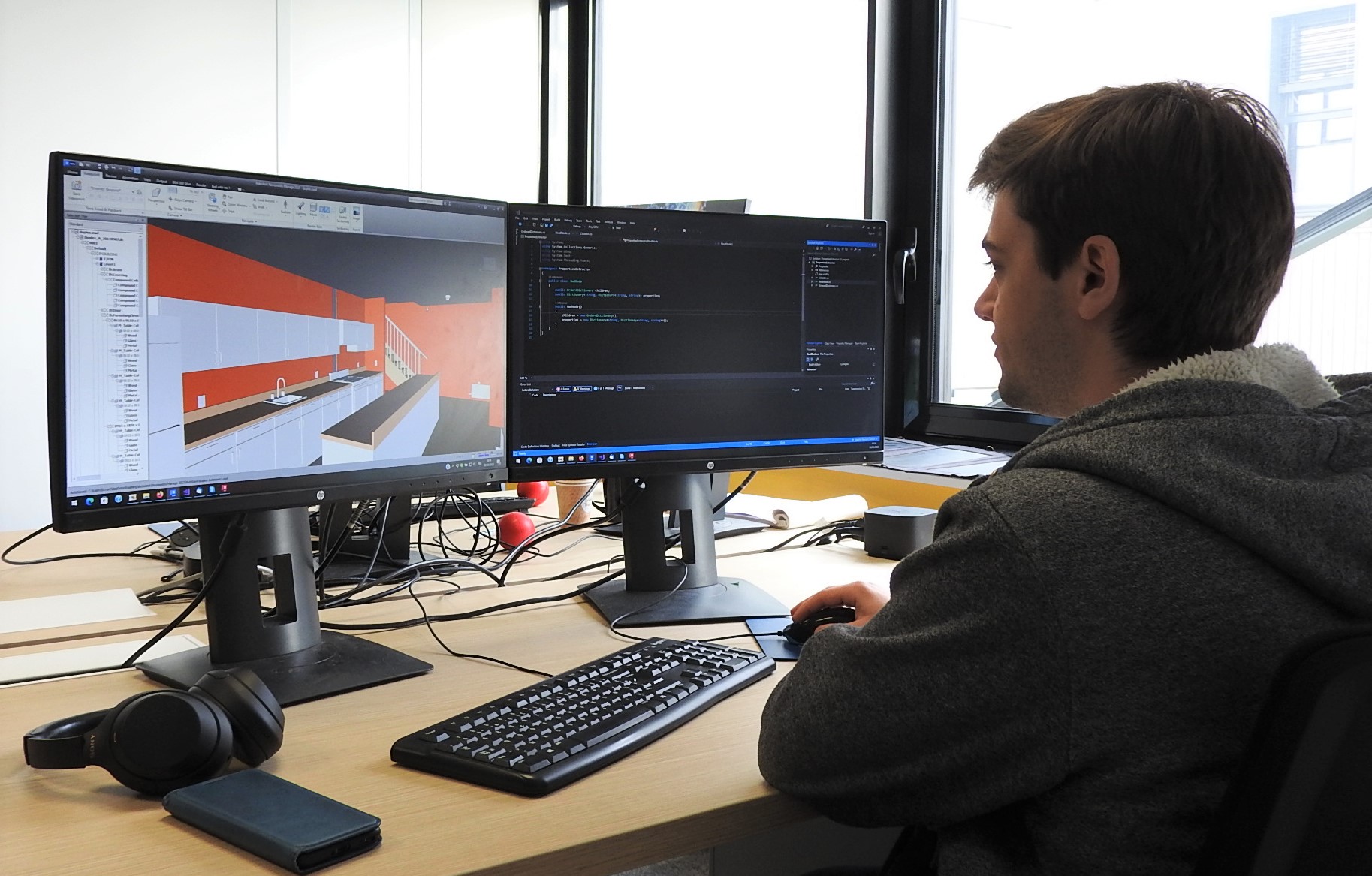
Datakit expands its range of data exchange solutions with a new converter dedicated to NavisWorks
This converter allows you to import a project designed with NavisWorks either to view it or to rely on its data to go further in the operational management of a building, a factory [...]
March 28, 23
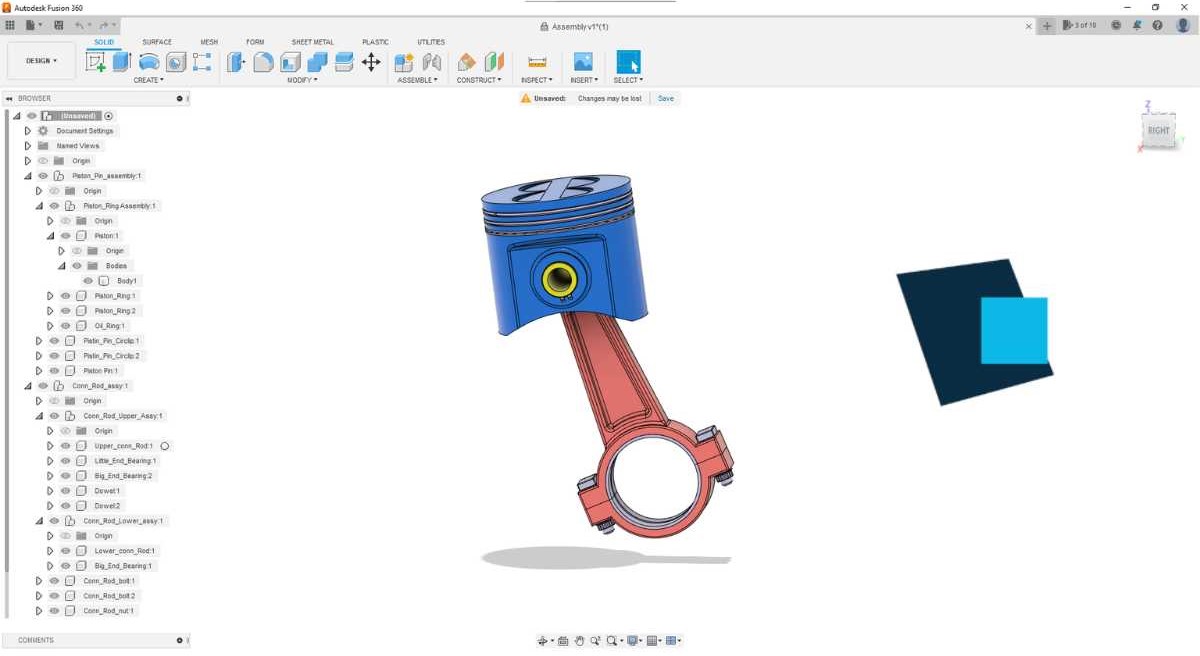
Datakit announces release 2023.1 of its converters
As a player in interoperability from the outset in 1996, Datakit is again strengthening its presence on the 3D engineering market with a new conversion tool for the F3D format. As [...]
January 16, 23

Datakit among the players at MBx Interoperability Forum
Datakit has been active in the STEP community for decades. It was and is a significant player in the definition of STEP AP242.Datakit is a member from start of CAx-IF, PDM-IF, [...]
December 06, 22

Version 2022.4 of Datakit 2D and 3D converters is released
With this version, Datakit further enhances interoperability between 3D engineering software, worldwide. Many changes have been made to Datakit’s data exchange toolkits to [...]
November 22, 22
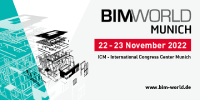
BIM World MUNICH 22 – 23 November 2022 - ICM Munich
Datakit is delighted to meet BIM players, November 22 and 23 at BIM World MUNICH 2022As an expert in data exchanges, Datakit is used to working closely to software editors, [...]
November 10, 22
Version 2022.2 of the Datakit 2D and 3D conversion libraries has been released!
Since 1992 Datakit's unique business is to provide solutions for reading and writing detailed 2D and 3D technical data. The release 2022.2 of Datakit’s conversion toolkits [...]
May 05, 22

Datakit, specialist in 3D interoperability, announces the new version (2022.1) of its technical data conversion SDK
Since 1994 Datakit facilitates the exchange of 2D and 3D data for users and developers of CAD, CAD/CAM, 3D visualization, simulation, metrology, and modeling applications. The [...]
February 01, 22

Datakit releases version 2021.4 of its technical data exchange software
Datakit, the independent CAD interoperability specialist, releases version 2021.4 of its SDK. The Datakit conversion solution can now read glTF files, as well as the latest [...]
October 07, 21

The version 2021.3 of Datakit’s file conversion software is available
Datakit, specialist in data transfer between CAD systems, announces the availability of version 2021.3 of its software. It adds support for the latest versions of ACIS, Inventor, [...]
July 30, 21

Datakit presents tools for reading the SMG format
The French specialist in data transfer between CAD systems completes its offer with tools for reading files in SMG format. This is widely used for creating technical documentation [...]
July 20, 21

Datakit releases new version (2021.2) of its 2D/3D CAD file converters with new read/write functionalities
Datakit is a major independent player in CAD/CAM file converter markets. Constant improvement of its software performance and coverage is key in company’s strategy. Datakit [...]
April 20, 21

Enventive licenses Datakit technology for 3D CAD data import
Enables using existing CAD solid models to perform rapid and effective tolerance analysis Datakit, a leading CAD Data Exchange Company, announces that Enventive has licensed [...]
March 03, 21

Datakit announces version 2021.1 of its CAD file converters
To start this year 2021 well, Datakit presents the new version of its software. It adds a new library for reading the FBX format, support for ACIS .asab files, support for the [...]
January 11, 21

Textures: one of Datakit's know-how
Datakit enriches its range of tools for importing and exporting 3D files, by providing some of them with functionalities allowing the conversion of files with their textures. The [...]
December 15, 20

VRSquare licenses Datakit technology for 3D CAD data import
Providing interoperability between game-changing optimization for AR/VR applications and CATIA V5 3D data Datakit, a leading CAD Data Exchange Company, announces that VRSquare [...]
November 24, 20

Datakit beside Lesage Motors with CrossManager
Datakit provides Lesage Motors with a license of CrossManager to allow it to import files in STEP format to SolidWorks. The editor thus intends to help a small structure which is [...]
October 29, 20

A prolific confinement … for Rhino 3D plug-ins
The period of home confinement has been a period of intense activity for the developers of Datakit, French specialist in data transfer between CAD systems. Around Rhino 3D, no less [...]
July 30, 20

The version 2020.3 of 3D and 2D data conversion software from Datakit is available
Datakit, specialist in data transfer between CAD systems, announces the availability of version 2020.3 of its software. It adds support for the latest versions of CATIA V6 / [...]
July 16, 20

STEP AP242 edition 2: Datakit's 3D data conversion tools support the latest evolution of the STEP standard
The latest evolution of STEP AP242, edition 2, is now public. Datakit actively participated in its development, and is already ready to offer reading and writing of STEP AP242E2 [...]
June 11, 20

Datakit announces version 2020.2 of its 2D and 3D data exchange software
Datakit, specialist in data transfer between CAD systems, announces that version 2020.2 of its software is now available. It adds support for the latest versions of CATIA V5, CGR [...]
April 06, 20

A new library to write glTF format
The French data transfer specialist in CAD systems adds a writer for gITF format files to their current offer. It is widely used for displaying 3D models on the web and is [...]
March 16, 20

A new library for FBX format
The French data transfer specialist in CAD systems adds a writer for FBX format files to their current offer. It’s a fast and compact format used mainly in the animation world [...]
February 27, 20

Datakit announces version 2020.1 of its CAD file converters
Writer libraries in FBX and glTF formats are now available, as well as conversion support for new versions of Solid Edge, ACIS, NX, SOLIDWORKS and PARASOLID files. Datakit's [...]
January 10, 20

Datakit expands its range of Rhino plug-ins
The French specialist in data transfer for CAD systems adds to their Rhino offer with new plug-ins for CreoView, Revit and IFC formats. This has also led to the creation of a [...]
December 20, 19

Intense activity on STEP AP242
The end of year 2019 was marked by several events concerning STEP used in PLM, in regard of the upcoming publication of the Edition 2 of STEP AP242: - STEP AP242 Day, on [...]
December 13, 19

New features for version 2019.4 of Datakit's CAD file converters
3D file conversion to FBX and glTF formats is now possible, new versions of Creo Parametric, Parasolid, NX and Solid Edge, and three new plug-ins for Rhino have been developed. [...]
November 19, 19

The version 2019.3 of Datakit’s CAD and BIM formats converters is available
New versions of CATIA V6 / 3DEXPERIENCE, Inventor, NX, Revit and IFC are supported. The latest update of Datakit’s 2D and 3D data exchange software range is now available! It [...]
July 04, 19

The version 2019.2 of Datakit’s 2D and 3D formats conversion software is available
The latest update of Datakit’s CAD data exchange software range is now available! It adds the support for new CAD and BIM formats versions reading, for all Datakit applications: [...]
April 05, 19

Datakit announces the version 2019.1 of its CAD conversion tools
The latest update of Datakit’s CAD data exchange software range is now available! It adds the support for many new CAD formats versions reading, for all Datakit applications:- [...]
January 23, 19

Datakit announces the version 2018.3 of its CAD conversion tools
The latest update of Datakit’s CAD data exchange software range is now available! This version adds the following improvements: - New CAD formats versions are supported: Inventor [...]
July 23, 18

Kubotek licenses Datakit technology
Datakit, a leading CAD Data Exchange Company and Kubotek3D, developer of 3D mechanical CAD software, announce that Kubotek has licensed Datakit translation technology for inclusion [...]
July 11, 18

Datakit announces the version 2018.2 of its CAD conversion tools
The latest update of Datakit’s CAD data exchange software range is now available! This new version of CrossManager, CrossCad/Plg and CrossCad/Ware adds the following [...]
May 31, 18

Datakit CAD import & export plug-ins are now available with Rhino 6
Datakit, leading company in CAD data exchange announces that CrossCad/Plg, its range of CAD import and export plugins for Rhino, is now available with Rhino 6. Datakit follows [...]
March 09, 18

Datakit announces the version 2018.1 of its CAD conversion tools
The latest update of Datakit’s CAD data exchange software range is now available! This new version of CrossManager, CrossCad/Plg and CrossCad/Ware adds several improvements to [...]
January 24, 18

Datakit expands its BIM offer with a Revit format reader
Datakit unveil its brand new interface: a library to read Revit files (*.rvt), the native format of the well-known Autodesk’s BIM software. This new interface expands Datakit’s [...]
January 17, 18

Datakit announces the version 2017.4 of its CAD conversion tools
The latest update of Datakit’s CAD data exchange software range is now available!This new version of CrossManager, CrossCad/Plg and CrossCad/Ware adds new improvements to [...]
October 16, 17

Datakit announces the version 2017.3 of its CAD conversion tools
The latest update of Datakit’s CAD data exchange software range is now available!This new version of CrossManager, CrossCad/Plg and CrossCad/Ware adds the support of new versions [...]
July 18, 17

Datakit helps students to build an innovative vehicle for the EducEco challenge
Students from Arnaut Daniel high school (Ribérac, France), are competing from today for the EducEco challenge: A competition which aims to design an innovative vehicle to travel [...]
May 19, 17

New SOLIDWORKS export plug-in for Rhino
Datakit, a leading company in CAD data exchange, offers a new SOLIDWORKS export plug-in for Rhino. It completes its wide range of plug-ins for Rhinoceros software. This new [...]
May 02, 17

Datakit announces the support of Creo Parametric 4.0 by its CAD data exchange tools, with many technical improvements
Datakit, a leading company in CAD data exchange, announces the support of the Creo Parametric brand new version 4.0, along with many technical improvements to its technology. [...]
April 27, 17

New NX export plug-in for Rhino
Datakit offers a new NX export plug-in for Rhino. It completes its wide range of interoperability plug-ins for Rhinoceros software. This new extension allows Rhino users to save [...]
March 07, 17

CrossManager 2017.1 converts SOLIDWORKS 2017 and CATIA V6 R2016x files
The version 2017.1 of CrossManager, the CAD files converter published by Datakit supports new versions of 3D formats.The software supports now the conversion of files coming from [...]
January 16, 17

Datakit’s new IFC reader allows interoperability between BIM and CAD
Datakit, a leading company in CAD data exchange, unveil its brand new interface: a library to read the IFC format (Industry Foundation Classes), the standard exchange format for [...]
January 03, 17

The version 2016.3 of Datakit’s conversion tools enables to write NX™ assemblies
Datakit has been providing for one year a Siemens™ NX™ format writing interface. Following the enthusiasm generated by this new interface and the requests of its users, Datakit [...]
July 05, 16

Datakit enables to 3D print most CAD formats through the 3MF format
Datakit, CAD data exchange software vendor, has developed a library to write 3MF files (3D Manufacturing Format). While a STL file only defines the geometry of the model to print, [...]
June 02, 16

Datakit imports assemblies from CAD formats into Rhino, and strengthens its plugins bundle
Datakit, a leading CAD file conversion software vendor, announces that its CAD import plug-ins for Rhino are now able to maintain the assembly structure of the original model. [...]
May 11, 16

Datakit is offering users of CrossManager an export in STEP format at no additional cost
From now, the STEP format export 3D function (geometry and assemblies) is included in each CrossManager license having at least one 3D input. CrossManager is a converter supporting [...]
April 07, 16

Datakit expands its bundle of plug-ins for ThinkDesign with two new CAD import formats
Datakit offers two new import plug-ins for ThinkDesign. They enable ThinkDesign users to import files in JT (.jt) and Rhino (.3dm) formats in ThinkDesign very easily. These [...]
March 07, 16

GF Machining Solutions and Datakit combine their technologies to facilitate use of a number of CAD formats
GF Machining Solutions, manufacturers of machine-tools, delivers machines with a software suite composed of Rhinoceros software for modelling and visualising pieces before [...]
December 17, 15

Update of whole Datakit software range
Datakit has released the version 2015.4 of its CAD / CAM data exchange tools. It applies to all product lines of the company (CrossManager, CrossCad/Ware and CrossCad/Plg). This [...]
October 07, 15

New CAD import plug-ins for Open Cascade
Datakit has developed two new plug-ins for Open Cascade.With these plug-ins, it is possible to import 3DM (Rhino) files and DXF/DWG (Autocad) files into all applications based on [...]
September 25, 15

Prima Power uses Datakit technology for 3D CAD data import
The recent release of Prima Power’s NC Express e3 CAM software leverages Datakit technology for 3D CAD model interoperability. Prima Power has licensed a broad range of import [...]
September 21, 15

New NX™ export
Datakit has just released a brand new Siemens™ NX™ format export interface. This interface is available in CrossCad/Ware, enabling software vendors to integrate a NX™ output [...]
July 03, 15

Datakit releases the version 2015.3 of its CAD data exchange tools
Datakit, a leading CAD data exchange company, releases the version 2015.3 of its CAD formats reading and writing interfaces. This version offers several new features: The [...]
June 30, 15

Datakit expands its range of Rhino plug-ins
Datakit, leading company in CAD data exchange, develops CrossCad/Plg: plug-ins for the CAD software Rhinoceros. Compatible with Rhino 4 and 5, these tools allow to import or export [...]
June 15, 15

3D PDF Consortium welcomes Datakit
Leading Data Translation Company Joins Industry Group The 3D PDF Consortium is proud to announce its latest independent software developer member. Datakit, a leading provider of [...]
May 06, 15

Open Inventor 3D SDK extends CAD support with Datakit libraries
FEI’s Open Inventor 3D software development tools (SDK) use Datakit technology to add extended support for importing CAD data.At CONTROL 2015, FEI will introduce Open Inventor [...]
April 20, 15

Onshape uses Datakit for 3D CAD data import and export
Datakit announces that the recent beta release of Onshape’s revolutionary browser based CAD environment leverages Datakit technology for 3D CAD model interoperability. Onshape [...]
April 09, 15

Datakit releases the version 2015.2 of its CAD data exchange tools
Datakit releases the version 2015.2 of its CAD conversion interfaces.This version offers three main new features:-The Solid Edge 2D (.dft) format is now available. It can be [...]
April 07, 15

Datakit improves its range of SOLIDWORKS converters
Datakit, leading company in CAD data exchange, develops converters for more than 40 CAD formats regularly updated. In the latest version of its software, Datakit has worked hard on [...]
March 16, 15

Geometry Comparison from LEDAS now supports all major MCAD formats with DATAKIT libraries
LEDAS Ltd., developer of CAD component software and a provider of development services for the engineering software market, today announced new capabilities in its LEDAS Geometry [...]
February 17, 15

Datakit supports the 4L Trophy
Two years ago, Datakit sponsored a 4L Trophy team.Datakit continues this year by supporting two teams of this humanitarian raid: 4L Trophy, embarquons ensemble and 4L DIF [...]
February 16, 15

New 3DXML export in CrossManager 2015.1
Datakit has released Cross Manager 2015.1.Besides many improvements to existing interfaces, this version offers a brand new 3DXML export interface. It is therefore possible to [...]
January 12, 15

STEP moves and Datakit is fully involved in this move
The new standard STEP AP242 has been published as ISO (begin December 2014). It's the outcome of numerous works, studies... in which Datakit regularly participates, in [...]
December 17, 14

Datakit improves its reading and writing interfaces for JT
Datakit, a leading CAD data exchange company, announces availability of the 2014.3 version of Datakit converters, bringing many enhancements and improvements with special focus on [...]
July 25, 14

Datakit extends its reseller network in Russia and China
Datakit has taken a new step towards the conquest of the Chinese and Russian markets, following the recent signing of agreements with local resellers. The past few months, Datakit [...]
April 24, 14

Datakit moves into new offices
Datakit has acquired new offices for his Lyon team which has moved this week.These offices, still located in Lyon, are at the following adress :99, rue de GerlandBâtiment 869007 [...]
April 18, 14

Datakit participates in the SIP project from IRT SystemX
Datakit participates in the SIP (Standards & Interoperability PLM) project organized as part of the IRT SystemX, launched in late 2013. This project focuses on the [...]
February 21, 14

Datakit releases CrossManager 2014.1
LYON, France,Datakit, a leading CAD Data Exchange Company releases CrossManager© 2014.1 update for CAD converters, along with plugins and SDK toolkits. Latest release comes with [...]
February 04, 14

Datakit meets LMBA to provide them with CAD converters
Dakar, Senegal, Francis Cadin, CEO of Datakit, has embarked on a world tour riding his motorcycle to meet customers and resellers all over the world. The second step of this trip [...]
January 08, 14

ANSYS licenses Datakit technology
LYON, France,Datakit, a leading CAD Data Exchange Company announces that ANSYS, a global leader and innovator of engineering simulation software, has licensed Datakit translation [...]
December 23, 13

Datakit meets Audros Technology to provide them with CAD converters
Marrakech, Morocco,Francis Cadin, CEO of Datakit begins a world tour on a motorcycle to meet his customers and resellers all over the world. The first step of this trip was [...]
October 24, 13

Datakit releases CrossManager 2013.4, meet us at EMO 2013
Datakit announces CrossManager© 2013.4 update for CAD converters, along with plugins and SDK toolkits. Datakit will be visiting EMO 2013 Sept 16-21, Hannover, Germany. We would [...]
September 09, 13

Datakit releases CrossManager 2013.3
Datakit announces CrossManager© 2013.3 update for CAD converters, along with plugins and SDK toolkits. CAD Formats update Latest release comes with several CAD readers updates : [...]
July 18, 13

Datakit supports the
After having sponsored the 4L Trophy, Datakit supports another event : The "rallye Aïcha des Gazelles", a raid for women only taking place in the Moroccan desert. The [...]
March 12, 13

Datakit strengthens its 3D PDF and STEP offer
Datakit, announces CrossManager© 2013 update for CAD converters, along with plugins and SDK toolkits. This release shows critical enhancements in 3DPDF output, including [...]
March 07, 13

Datakit is a supporting partner of the 4L Trophy
Datakit supports the 4L Trophy, a humanitarian raid aiming to provide school supplies to the neediest children in Morocco. It will run from 14 to 24 February 2013. We bring our [...]
February 13, 13

Major improvement of CATIA V5 3D to SolidWorks plugin
Our CATIA V5 import plug-in for SolidWorks begins the year with a new version compatible with SolidWorks 2013, and ensures major improvements with a conversion based on the new [...]
January 21, 13

CrossManager 2013 update
Datakit announces CrossManager© 2013 update for CAD converters, along with plugins and SDK toolkits. CAD versions update This release comes with several CAD readers updates : [...]
January 14, 13

The LOTAR + CAX-IF workshop has taken place in Darmstadt, Germany, on 4-6 December 2012
This time comes just before the ballot on STEP AP242 DIS (draft international standard) starts, one of the last stages before the publication of the new standard AP242 (Edition 1), [...]
December 04, 12

Datakit releases CrossManager 2013
Datakit announces CrossManager© 2013 update for CAD converters, along with plugins and SDK toolkits. This includes support formats extensions for COLLADA and Adobe© 3D PDF file [...]
October 10, 12

Visit of Department of Science and Technology of Shandong
Datakit today received the visit of representatives of the Department of Science and Technology of Shandong Province, China. Image 1 Image 2
September 21, 12

Participation of Datakit to the LOTAR/CAx-IF work-shop from September 17 to 19
Datakit has participated in the work-shop LOTAR / CAx-IF which has taken place in Gaithersburg, USA, from September 17 to 19, 2012. Main topics have been preparation of STEP AP242 [...]
September 17, 12

COLLADA writing
Datakit has developed a new COLLADA writing, allowing to convert most CAD formats in COLLADA with our software CrossManager.
July 30, 12

New plug-in to export JT using SolidWorks
It is now possible to write files to the JT format directly from SolidWorks with our new export plug-in : "SOLIDWORKS 3D to JT". The export is done very easily from a [...]
July 25, 12

June 2012 is a high date in the evolution of STEP AP242.
DATAKIT is fully involved in the current activities around STEP AP242, in particular the LOTAR/CAx-IF work-shop which will take place in Toulouse (France) on June 26-28, 2012. The [...]
June 21, 12

CrossManager in 5 languages
CrossManager is now available in 5 languages: English, French, German, Italian and Czech.
April 20, 12
PlmXml format
Datakit completes its range of products offering PLMXML format. To expand the list of importers, Datakit offers its customers a library of reading PlmXml and / or interfaces, [...]
December 27, 11

Ug/NX 8 available
The new version of the CAD solution, Ug/NX 8 , is now supported by all Datakit ranges of converters.Datakit SDK (Ug/NX Reader) and CrossManager (Ug/NX To Iges, Step, Jt, Stl...).
December 26, 11

Datakit will be at SolidWorks World 2012
SolidWorks World 2012 will be held February 12-15, 2012 in San Diego, California, USA.Datakit will be there to demonstrate his SolidWorks converters and show you their quality and [...]
December 01, 11

Datakit participates in LOTAR works on STEP AP242
LOTAR & CAX-IF - Charleston , SC - USA Datakit has participated in the LOTAR work shop and the CAX-IF meeting, on 26-28th of September 2011. Works were mostly focused on [...]
October 06, 11

Exchanging 3D Models with PMI using STEP
Article by Datakit in ProductData Journal, edition 2011-1, published by ProSTEP iViP Association Christian Caillet DATAKIT Lyon, France Summary The new STEP protocol AP242 is aimed [...]
July 21, 11

Simplification of the conversion of native CAD to OpenCascade
Datakit now provides CAD readers to OpenCascade in a new form, for easier integration, extension, maintenance and use : One unique DLL for all readers Common call form for all [...]
June 28, 11

New plug-in CATIA V6 3D to SOLIDWORKS
Datakit now offers a new plug-in to import CATIA V6 files (.3dxml) into SolidWorks.
May 19, 11

Datakit now offers plug-ins for the version 5 of Rhino, and adds a CATIA V6 import.
These converters are perfect complements of the standard Rhino 5 functionalities. Supported data : Part and assembly files. Geometry. Wireframe. Meshes. Topology. Maintenance : [...]
April 12, 11

CATIA V6 available
The new version of the CAD solution, CATIA V6 , is now supported by all Datakit ranges of converters.Datakit SDK (CatiaV6 Reader) and CrossManager (CatiaV6 To Iges, Step, Jt, [...]
March 27, 11

Datakit completes its range of converters with new plugins in ThinkDesign.
Datakit completes its range of converters, It allows the translation to Think3, of 3D models and assemblies coming from these CAD formats :Acis, Catia V4, Catia V5, Inventor, [...]
February 09, 11

New dental formats
Datakit completes its range of products offering dental formats. To expand the list of importers, Datakit offers its customers a reading library for "Procera (Nobel [...]
February 04, 11

Datakit, your provider with CAD data readers and writers, native and neutral
Datakit supports new formats : JT - 3DXML/CatiaV6 - Datakit XML proprietary format Dental Formats : Nobel Biocare/PROCERA - Sirona/CEREC - Dentply/CERCON - 3shape New capabilities [...]
October 01, 10

Datakit completes its range of converters to OpenCascade.
It allows the translation to OpenCascade, of 3D models and assemblies coming from these CAD formats : CatiaV5, UG-NX, SolidWorks, SolidEdge, CatiaV4, Pro/Engineer, Inventor, [...]
July 01, 10

Global Vision Systems uses Datakit software to convert CAD models of an Airbus A350
The vendor of 4D supervision and instrumentation PLM solutions is using conversionsoftware from the data exchange specialist. Global Vision Systems (www.global-vision-systems.com) [...]
June 17, 10

DATAKIT participates in LOTAR works, focusing on archiving PMI
DATAKIT has participated in the last LOTAR workshop which has held in Toulouse, France, from 14th to 17th of June 2010. About archiving of PMI in STEP, a global check has been done [...]
June 17, 10

New Procera interface
Datakit completes its range of products offering dental formats.To expand the list of importers, Datakit offers its customers a library of reading "procera" and / or [...]
June 08, 10

DATAKIT participates in LOTAR works, focusing on PMI
An initiative to propose a new evolution of STEP has been promoted by the LOTAR group, especially to improve the capabilities of STEP to address the needs of long term archiving of [...]
March 24, 10

Pro/E Wildfire 5 mastered
The new version of the CAD solution, ProEngineer Wildfire 5, is now supported by all Datakit ranges of converters. Our knowledge of the ProE format allowed us to be very reactive [...]
December 02, 09
Datakit Processes CADDS parametric
CADDS, a CAD/CAM software widely used in the shipbuilding and aeronautical domains, usesCADDS, a CAD/CAM software widely used in the shipbuilding and aeronautical domains, uses two [...]
November 24, 09

Datakit : Your provider for CAD libraries
Extensive Data coverage including: Assembly, part, Drawing, Geometry, Topology, Mock-up model, PMI, Fdt, Capture, Piping, Tubing, Harness, Cabling, Scenes, Features, Meta-data, [...]
November 01, 09

Sycode and Datakit collaboration
Sycode and Datakit has entered a close colaboration to offer high-end data exchange solutions.Datakit data exchange technology will thus be embed in new and upcoming Sycode's [...]
July 28, 09

Datakit takes part to the LOTAR workgroup
Datakit has been invited to join the LOTAR (LOng Term Archiving & Retention) workgroup, to work on the extension of the STEP norm for the needs of long-term CAD data [...]
June 29, 09

Datakit offers a new option for accessing CrossXpert, its advanced technology for CAD data conversion
CrossXpert is Datakit’s conversion modeler. Featuring powerful integrated tools that analyze and automatically repair CAD models, it embodies all the experience acquired by [...]
March 23, 09

Substantial price cuts on dedicated SW converters and new interface packs
With SolidWorks World 2009 just a few days away, Datakit announces substantial price cuts on its dedicated SolidWorks converters and new interface packs. In the last two years, [...]
January 26, 09

All CAD converters in one Rhino Plug-in. Datakit now offers two bundles
Benefits: A large choice of CAD file exchange solutions available on the designer’s PC Simple “all-in-one” installation More competitive pricing Clearer presentation of the [...]
January 22, 09

Datakit in China: the road so far and the road ahead
For a market-leading vendor of CAD data exchange solutions like Datakit, China is potentially a bigmarket that should start to deliver results in 2009. Since October 2007, [...]
January 19, 09

A wide range of new releases to start the year!
The Christmas break will be short at Datakit as the software developer announces a wide range of new releases to start the year. Users of CATIA V5 and NX converters will [...]
January 07, 09

Seasons greating
All of us here at DATAKIT would like to wish you and your loved ones a very happy holiday season!
December 18, 08

Datakit helps Wrapstyler to find a way round any 3D shape
Polyquark develops and markets Wrapstyler, a trim design package for the automobile and aircraft industries. The software is used for the whole trim design process for car and [...]
December 02, 08

New version of Datakit’s ROBCAD translators
Benefit from :- The speed of conversions - The stand-alone capability of the solutions, cutting out the need for source or target software licenses - The results: the ability to [...]
October 20, 08

Solutions for the use of data in the long term
Datakit will be presenting its viewpoint as vendor of data exchange solutions for the long-term archiving and reuse of CAD data.
October 10, 08

Job Opportunities
Datakit is offering two career opportunities : a sales support engineer to strenghten its Crosscad/Pro business unit and a research and development engineer
September 15, 08

Translators compatible with NX6
With the launch of NX6 just a few weeks away, Datakit already has converters for the new version ready and on line.
September 09, 08

Datakit doubles its floor space and its turnover
Since it started business in 1994, Datakit has developed considerably. Its success has been based on its ability to offer unique functionality to a user community that is fully [...]
July 02, 08

Exporting parts and assemblies from SolidWorks to Catia V5
This interface will be great news for many SolidWorks users who do not have a Catia V5 licence but need to supply their customers with files in this format.More about the plug-in!
May 28, 08

Datakit rises to the challenge of FDT and PMI
Last week, Francis Cadin, CEO of Datakit, attended the 3D Collaboration & Interoperability Conference, where the integration of PMI and other related information with 3D CAD [...]
May 19, 08

Spaces dedicated to Datakit’s end users and resellers
We are happy to remind you that a new free service is available for end-users and our resellers. Our goal is to facilitate sales, support and to help you being informed regarding [...]
May 06, 08

Datakit plug-ins have been certified for Inventor 2009
This certification ensures that the translators have met the standards established by Autodesk in terms of interoperability, quality and overall robustness. 5 native plug-ins [...]
April 23, 08

Onesia has selected Datakit
Onesia has selected Datakit to supply its solutions for tessellation and to read files in native Catia V5, Pro-Engineer, SolidWorks formats and IGES and STEP neutral formats
April 15, 08

INTEROPERABILITY SURVEY
Participate in 2008 Cad Cam interoperability survey by clicking just here Thanks in advance for your time and interest
March 28, 08

New JT to VRML and JT to STL. No JT Open lic requested
Datakit is launching two new stand-alone CAD data conversion modules: JT to VRML and JT to STL
March 13, 08
An interview of Francis Cadin
Rita Stange, ConnectPress Staff Writer, published the following Interview of Francis Cadin intitled "Francis Cadin's Pursuit of Happiness" within the SolidWorks [...]
February 26, 08

Datakit to show advantages to use Cadfix
Come and discover CADfix the ideal solution for anyone who needs to: - share product data between departments or with customers and suppliers - reuse solid model geometry in [...]
February 19, 08

Datakit is GOLD certified by the SolidWorks Partner Program
Datakit has achieved Gold Partner status with SolidWorks Corporation for the integration of Catia V5 and SolidWorks 3D CAD software. This translator Catia V5 to Solidworks will be [...]
January 17, 08

Season's Greetings
Datakit wishes you a very happy and prosperous New Year. Thanks for your confidence and collaboration during 2007. 2008 should be an interesting year with reliable and powerful [...]
December 20, 07

K Fischer Manager in the AMT group at Rockwell Collins comments it experience of STEP
Kevin Fischer is the PDES, Inc. Technical Advisory Committee representative for Rockwell Collins. He is a manager in the Advanced Manufacturing Technology (AMT) group at Rockwell [...]
December 18, 07

A complete process for cad data exchange solutions
Datakit has acquired the data transfer business of the company Ingetech and will be distributing the CadIQ, Cadfix, and DEXcenter products
November 12, 07

Datakit announces its new SolidWorks plug-in that enables to import parts and assemblies from Inventor to SW
The plug-in provides design offices using SolidWorks with an efficient, upgradable way of getting geometrical representations of Inventor assemblies and assembly trees into their [...]
November 05, 07

Lattice Technology Co, Ltd. builds Datakit's STEP component into its XVL Studio Ver 7.1
Lattice Technology Co, Ltd. was founded in 1997, when the Internet boom was at its peak, by Hiroaki Chiyokura (Professor, Environmental Information, Keio, Japan). The [...]
November 01, 07

From the transfer of associative 3D annotations and to the tolerancing & dimensioning data or the validation Properties: hard job for the members of the Cax-IF forum
For many years, Datakit has been actively involved in defining and developing the STEP standard; and participates regularly in the Cax Implementor Forum (CAx-IF), where [...]
November 01, 07

A complete process for data exchange solutions
Datakit has acquired the data transfer business of the company Ingetech and will now be distributing the CADIQ, CADfix, and DEXcenter products from ITI [...]
November 01, 07

MecSoft bundles Datakit's SolidWorks translators with VisualMILL 6.0
The latest version of VisualMILL 6.0, a manufacturing system that works with data from many CAD systems integrates SolidWorks data translator delivered by Datakit and allows [...]
November 01, 07

Be Simply connected! Discover the new Datakit web site and the comprehensive world of CrossCad
You'll realise at a glance that the Datakit web site has received a complete facelift. We know you can't wait to get clicking, but before you start [...]
November 01, 07
I haven't an Inventor licence, but wish to read in SolidWorks parts and assemblies designed with Inventor. Have you got a solution ?
Yes a plug-in is available that enables to read not only parts but also assemblies designed in Inventor V10, V11 and 2008. Does the plug-in operate from [...]
November 01, 07

Interview F Cadin - Blog Novedge
Francis Cadin is the CEO and founder of Datakit, the French company specialized in CAD data translation. Datakit products come in two different flavors: some translators perform [...]
September 27, 07

Datakit strengths its leadership in the field with the launch of a PMI option for NX5
PMI option for NX 5 and a new capability for reading Pro-E annotations
July 20, 07

Datakit demonstrates its ability to master Catia V5 FTA module
Integrating dimensioning and tolerancing into 3D models : Catia V5 FTA Module
July 15, 07

Datakit brings a new dimension to the 9.0 solutions from Rasterex
The Norwegian company Rasterex is one of the main players on the image processing market, offering solutions for visualisation, raster editing and raster-to-vector drawing [...]
June 01, 07

Datakit announces the release of a read/write library for Step
Datakit designs its libraries for software companies seeking to go beyond mere file-to-file transfer with sophisticated capability for processing data attributes. The new release [...]
June 01, 07

Sharc, specialist in volume meshing has chosen Datakit as a partner for its CAD data exchange
The company Sharc (http://www.sharc.co.uk/) is based in Manchester (UK) where, since 1997, it has been developing Harpoon, a solution for the generation of volume meshes. It works [...]
June 01, 07

PMI, FD&T, GD&T, MBD: hot niches for the engineering community !
Recent weeks have been a busy time for engineering conference goers with COFES, SME, CONTROL and a number of user events. In Europe and the USA, one topic has been topping the [...]
June 01, 07

Datakit rethinks one of its most popular converters: Catia V5 to SolidWorks
Datakit's converters, with their unique depth of capability, have become a favourite of the SolidWorks community. These tools enable users to transfer a wealth of native data: [...]
May 01, 07

Datakit to showcase its latest technologies at RAPID 2007 Conference & Exposition, Detroit, MI
We especially expect to meet software companies interested by our technology as a Cad data exchange core solution, but also end users involved in design, prototyping, tooling, and [...]
April 01, 07

SolidWorks users now benefit from a sexier line of stand alone converters
Datakit's complete range of stand-alone converters including SolidWorks ones has had a complete facelift.The end result comes to you with a modern, user-friendly appearance [...]
January 01, 07

Datakit posts a 40% increase in revenue for 2006
Datakit, a Cad Data Exchange leading company today announced that it boasted a successful year in 2006, consolidating its business with major and niche software vendors worldwide. [...]
January 01, 07

A sexier product line: CrossCad replaces Detk
Datakit's complete range of stand-alone converters is benefiting from a complete facelift. The end result will come to you with a modern, user-friendly [...]
January 01, 07

VB2S integrates Datakit's native Catia V4 and V5 converters, consolidating the positioning of its Subdo software for the creation of 3D presentations for the industrial market
The company's founders were sensitive to the needs of companies in many fields who were reluctant to use complex IT and animation tools, and set out to develop an accessible [...]
January 01, 07

Close collaboration between MDTVISION and Datakit to get digital data
Prelude INSPECTION is the 3D metrology solution developed by MDTVISION. As an IBM subsidiary, the company's goal is to develop the group's PLM strategy in France and [...]
January 01, 07
Datakit new customers in 2007
ActuaPlast Actuaplast is a company that specialises in the design and manufacture of plastic parts for the automotive and electrical/electronics industries, but also [...]
January 01, 07

Happy new year !
All of us at Datakit offer you our very best wishes for a healthy and prosperous New Year. To start 2007, here's a conundrum! What do the flagship [...]
January 01, 07

Datakit offers Catia V5 to Rhino 4.0 conversion in batch mode
Why bring out a batch version ? Designers often see importing data as a laborious, uncreative chore. Automation helps creative people to save precious time and energy. [...]
January 01, 07

Datakit launched its full CGR read and write capability
CGR geometry is supported. Facets, groups of facets and boundaries are supported as well as attributes such as textures and colours. Assemblies are handled and enable the exchange [...]
December 01, 06

Who or what is CGR ?
The CGR (Catia Graphical Representation) is the triangulated format used by Catia V5. This faceted surface representation makes it quicker to load Catia V5 CatParts and [...]
October 01, 06

The butterfly effect !
The idea that a file exchange and conversion process could extract and manage not just geometrical data but all the information needed to develop a product used to be a pipe dream. [...]
October 01, 06

McNeel is using Datakit's technology in Rhino 4.0
McNeel and Datakit recently worked together to develop a data exchange solution between SolidWorks and Rhino 4.0, based on Datakit's topological model. This interface, [...]
October 01, 06
New Datakit customers
The Acoustics & Environment Department of AIRBUS France uses CATIA V5 3D to OPEN CASCADE The Acoustics & Environment Department is responsible for the global noise [...]
October 01, 06

Tips and Tricks - FD&T processing options
By default, Datakit processes Catia V5 FD&T data in its Catia V5 to Iges interface, but recently introduced an option box enabling users to choose whether or not they want to [...]
October 01, 06

Wilcox measures the advantages of Datakit for reading GD&T and FD&T in CATIA V5 models
Wilcox Associates Inc. develops the PC-DMIS measurement and inspection software. It is one of the many subsidiaries of Hexagon Metrology group, including prestigious [...]
July 01, 06

Weight watchers welcome a new fast, precise flawless STL !
STL, the precursor of the world’s streamlined data formats, was created in 1990 by 3DS, the leading rapid prototyping vendor. It’s underlying principle is to represent geometry [...]
July 01, 06

The aerospace industry in STEP at Cannes
Some data exchange formats come and go like fashionable clothes: here today, gone tomorrow. Others become part of the landscape and are even adopted as industry standards. The [...]
July 01, 06

The new Trans-Xpert solutions for SolidWorks and WorkNC shine at IVR
Datakit teamed up with Coretech International to develop dedicated Trans-Xpert solutions for SolidWorks and WorkNC. The new software was developed in [...]
July 01, 06

Datakit has been asked by Open Cascade to develop tools for exchanging data in native formats
Since the turn of the year Open Cascade has been a subsidiary of EURIWARE, an IT consulting and services group, itself a wholly-owned subsidiary of energy giant AREVA. Open Cascade [...]
July 01, 06
Tips and Tricks - Catia V5 import in Inventor
We know that many of you have been waiting impatiently for a way to import all Catia V5 assemblies into Inventor 11 without losing the assembly structures. We are now proud to [...]
July 01, 06

Datakit, Inc. is born !
The US subsidiary of Datakit is based at Santa Barbara, California and is managed by Francis Cadin, who recently moved to the States to take care of the business. The sheer size of [...]
June 01, 06

Weight watchers welcome a new fast, precise flawless STL!
Datakit has for several years been committed to finding ways to get round these precision and topology issues frequently encountered in STL. Its team has been collaborating closely [...]
June 01, 06

Integrating 2D-CAD data into a 3D model
Kantemir is specialised in the fabrication of custom mold bases. The company has ISO 9001-2000 certification, does 70% of its business on the export market, essentially in the [...]
April 01, 06

Alibre users are even more independent with Datakit’s native interfaces
Usicad is the sole importer of Alibre software in France. Loyal to the CAD vendor’s strategy, it applies a principle that is often used by CAD suppliers, namely that it brings 3D [...]
April 01, 06

Model analysis and quality
Model quality is a critical issue for manufacturing companies worldwide. France’s automotive makers and their first-tier suppliers recently got together to draw up a list of the [...]
April 01, 06

Is the American dream still alive ?
Francis Cadin, Datakit CEO, met so many people at SolidWorks World 2006 in Las Vegas that he decided to cross the Atlantic again to check out two major trade shows: NDES in [...]
April 01, 06

Tips and Tricks - Batch conversion
Datakit offers all SolidWorks users a solution for converting batches of Catia V5 files with automatic assembly processing. Note that batch mode is only available after the [...]
April 01, 06

Tips and Tricks - Previews
The previews available for the Catia V5, SolidWorks and UG interfaces have been so successful that we have decided to develop a similar tool for users of the Pro-E converters. To [...]
April 01, 06
